BIOS 242 (BIOS242)
Chamberlain College Nursing
Page 4 out of 57 results
Sort by
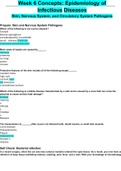
-
BIOS 242 Week 6 Concepts; Epidemiology of Infectious Diseases
- Other • 8 pages • 2023
- Available in package deal
-
- $35.49
- + learn more
Week 6 Concepts: Epidemiology of Infectious Diseases Skin, Nervous System, and Circulatory System Pathogens Prepare: Skin and Nervous System Pathogens • Which of the following is not a prion disease? • Most cases of sepsis are caused by . • Protective features of the skin include all of the following except . • Which of the following is a febrile disease characterized by a rash and is caused by a virus that can cross the placenta to cause serious fetal damage? • The transmissi...
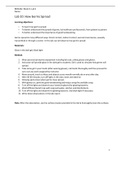
-
BIOS 242 Week 5 Lab 2; How Germs Spread
- Other • 4 pages • 2023
- Available in package deal
-
- $25.49
- + learn more
Lab 10: How Germs Spread Learning objectives: • To learn how germs spread • To better understand the spread of germs, by healthcare professionals, from patient to patient • To better understand the importance of good handwashing. Germs spread in many different ways. Direct contact, indirect contact, aerosol transmission, sexually transmitted or through a vector. In this lab, we will observe how germs spread. Materials: Glow in the dark gel, Black light Method: 1. Wear pers...
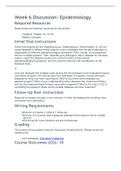
-
BIOS 242 Week 6 Discussion; Epidemiology
- Other • 2 pages • 2023
- Available in package deal
-
- $20.49
- + learn more
Initial Post Instructions Some microorganisms like Staphylococcus, Streptococcus, Yesinia pestis, E. coli can cause diseases of different body systems. Let's investigate how the same pathogen is responsible for different pathophysiological symptoms. First, choose a microorganism found in multiple systems. Then, describe your pathogen's role in disease for one body system: report the disease caused, the normal function of that system, pathophysiological symptoms, and the virulence factor(s) th...
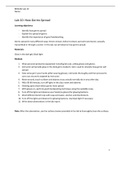
-
BIOS 242 Week 5 Lab 2; How Germs Spread
- Other • 4 pages • 2023
- Available in package deal
-
- $25.49
- + learn more
Lab 10: How Germs Spread Learning objectives: • Identify how germs spread • Explain the spread of germs • Identify the importance of good handwashing. Germs spread in many different ways. Direct contact, indirect contact, aerosol transmission, sexually transmitted or through a vector. In this lab, we will observe how germs spread. Materials: Glow in the dark gel, Black light Method: 1. Wear personal protective equipment including lab coat, safety glasses and gloves. 2. Inst...

-
BIOS 242 Week 5 Concepts; The Immune System
- Other • 9 pages • 2023
- Available in package deal
-
- $35.49
- + learn more
Week 5 Concepts: The Immune System Epidemiology Prepare: Epidemiology • The principal government agency responsible for tracking infectious diseases in the United States is the • The study of the frequency and distribution of a disease in a defined population is . • The Centers for Disease Control and Prevention assigns the most virulent microbes known to cause human disease to biosafety level 4. Self-Check: Epidemiology Drag the label to the following diagram according to the typ...
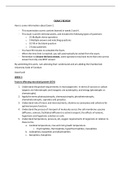
-
BIOS 242 Week 5 EXAM 2 Review. Chapters 7, 8, 11, 12, 13
- Other • 6 pages • 2023
- Available in package deal
-
- $29.49
- + learn more
Here is some information about Exam 2. • This examination covers content learned in weeks 3 and 4. • This exam is worth 120 total points, and includes the following types of questions: o 25 Multiple choice questions o 5 Multiple answer and matching questions o 10 Fill in the blank question o 2 Essay questions • You have 90 minutes to complete the Exam. • When the time limit is reached, you will automatically be exited from the exam. • Remember to choose the best answer, some q...

-
BIOS 242 Week 3 Concepts; Metabolism
- Other • 19 pages • 2023
- Available in package deal
-
- $29.49
- + learn more
Prepare: Factors Affecting Microbial Growth • The phase of the bacterial growth curve in which the rate of multiplication equals the rate of cell death is the . death phase • An organism that grows in lower pH conditions is called a . • An organism that uses organic carbon for its carbon needs and sunlight for its energy needs would be called a . Self-Check: Growth Requirements in Microorganisms • Place the images in order from top to bottom to show extracellular digestion in ...
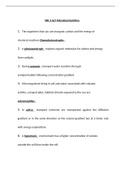
-
BIOS 242 Week 3 Assignment; Microbial Nutrition
- Other • 3 pages • 2023
- Available in package deal
-
- $25.49
- + learn more
1. The organisms that can use inorganic carbon and the energy of chemical reactions ______ . 2. A ______ requires organic molecules for carbon and energy from sunlight. 3. During ______ transport water transfers through semi permeable following concentration gradient. 4. Microorganisms living in soil and water associated with volcanic activity, compost piles, habitats directly exposed to the sun are ______. 5. In ______ transport nutrients are transported against the diffusion gradient or i...

-
BIOS 242 Week 2 Lab 2; Simple Staining
- Other • 16 pages • 2023
- Available in package deal
-
- $20.49
- + learn more
Lab 4: Simple Staining Learning Objectives: • To learn about principle of staining • To learn the process of simple stain • To prepare wet mount slides Exercise 1: Simple Stain Materials: Overnight cultures of S. epidermidis, B. subtilis, S. cerevisiae (yeast) , inoculating loop, glass slides, incinerators, crystal violet or any other stain chosen by instructor; tongs, staining racks/trays, immersion oil, lens paper, bibulous paper, microscope Method: 1. Obtain a clean glass slid...
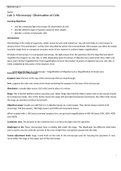
-
BIOS 242 Week 2 Lab 1; Microscopy
- Other • 11 pages • 2023
- Available in package deal
-
- $20.49
- + learn more
Lab 3: Microscopy- Observation of Cells Learning Objectives: • Use the compound light microscope for observation of cells. • Identify different types of bacteria based on their shapes. • Identify a variety of eukaryotic cells. Introduction: Exercise 2: Observation of Different Types of Bacteria Materials: Compound microscope, immersion oil, lens wipes, prepared slides of various bacteria- Rods, cocci and spiral Method: 1. Obtain the preserved slide of a bacteria. 2. Use Appen...

Did you know that on average a seller on Stuvia earns $82 per month selling study resources? Hmm, hint, hint. Discover all about earning on Stuvia


